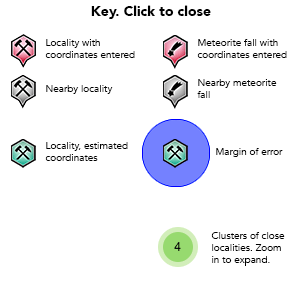Deep South Gold Mine, Mount Celia Station, Menzies Shire, Western Australia, Australia

| Latitude & Longitude (WGS84): | 29° 32' 40'' South , 122° 32' 32'' East |
|---|---|
| Latitude & Longitude (decimal): | -29.54452,122.54247 |
| GeoHash: | G#: qdxput8dw |
| Locality type: | Mine |
| Köppen climate type: | BWh : Hot deserts climate |
This is not the same gold mine as South Deep, the famous (maybe notorious) gold mine in South Africa. Deep South is 100 kilometres south of Laverton, and 5 kilometres east of the Safari Bore Gold Mine. Deep South is 600 metres east of the Mount Celia Road, as a hypersaline water filled open pit.
Deep South is hosted by meta sedimentary rocks. Proximal to the mineralisation is a narrow zone of high Mg basalt and ultramafic variably intruded with intermediate porphyry dykes. Gold is hosted in two parallel lodes called Scarlett and Butler. A carbonate unit formed a conduit from the mineral fluids, precipitating the gold.
Most gold is found in magnetite-pyrite-pyrrhotite-quartz-carbonate alteration, as distinctive zones of veining near the surface.
Saracen conducted a cut back operation in the old pit in 2013, and underground mining is slated for 2016. As of 2015, the pit is 600 metres long by 250 metres wide and up to 60 metres deep. It was developed between January 2004 to January 2005.
Commodity List
This is a list of exploitable or exploited mineral commodities recorded at this locality.Mineral List
5 valid minerals.
Rock Types Recorded
Select Rock List Type
Alphabetical List Tree DiagramRegional Geology
This geological map and associated information on rock units at or nearby to the coordinates given for this locality is based on relatively small scale geological maps provided by various national Geological Surveys. This does not necessarily represent the complete geology at this locality but it gives a background for the region in which it is found.
Click on geological units on the map for more information. Click here to view full-screen map on Macrostrat.org
| Quaternary 0 - 2.588 Ma ID: 693372 | colluvium 38491 Age: Pleistocene (0 - 2.588 Ma) Description: Colluvium and/or residual deposits, sheetwash, talus, scree; boulder, gravel, sand; may include minor alluvial or sand plain deposits, local calcrete and reworked laterite Comments: regolith; synthesis of multiple published descriptions Lithology: Regolith Reference: Raymond, O.L., Liu, S., Gallagher, R., Zhang, W., Highet, L.M. Surface Geology of Australia 1:1 million scale dataset 2012 edition. Commonwealth of Australia (Geoscience Australia). [5] |
| Neoarchean - Mesoarchean 2500 - 3200 Ma ID: 3187518 | Archean volcanic rocks Age: Archean (2500 - 3200 Ma) Comments: Yilgarn Craton Lithology: Greenstone belt; mafic-ultramafic volcanic rocks Reference: Chorlton, L.B. Generalized geology of the world: bedrock domains and major faults in GIS format: a small-scale world geology map with an extended geological attribute database. doi: 10.4095/223767. Geological Survey of Canada, Open File 5529. [154] |
Data and map coding provided by Macrostrat.org, used under Creative Commons Attribution 4.0 License
References
External Links
http://www.hawthornresources.com/project/deep-south.aspx



